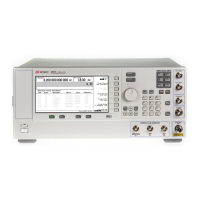E8257D/67D, E8663D PSG Signal Generators Service Guide
Troubleshooting
RF Path Description (Frequency Generation, Level Control, and Modulation)
1-105
An internal calibration source supplies the levels required to perform independent self tests. This enables the
firmware to check the A13 I/Q Multiplexer by setting known levels and reading the various nodes without actually
needing an I/Q signal.
An Offset Sense signal that comes in from the I/Q Modulators on the A8 Output is used to adjust for offsets between
the I and Q signals. The Offset Sense signal is compared to the I/Q signal output, and the result is used to control the
amplitude; the feedback signal minimizes quadrature and gain errors.
A14 Baseband Generator (Option 601/602)
The A14 Baseband Generator may be used as a dual arbitrary waveform generator, a real time I/Q baseband generator,
a noise generator, or a multitone generator. Customer–supplied waveforms can be downloaded into the waveform
memory to generate customized formats.
The I/Q bandwidth is 80 MHz for internally generated signals, and 160 MHz for externally generated I/Q signals. The
A14 Baseband Generator can generate symbol rates of up to 6.25 Msymbol/sec, and has 8 Msamples (Option 601) and
64 Msamples (Option 602) of waveform memory.
Data is sequenced from waveform memory by the field programmable gate array block (A1–FPGA), passed on to the
format builder block (A2–FPGA/Modulator/Filter), and finally to the output section. I and Q DACs at the output
convert the digital waveform data to analog. The I and Q output DACs are driven by a sample clock generated by an
on–board VCO. The VCO has a frequency range of 200 to 400 MHz. A 10 MHz reference signal from the A7 Reference
(or an external 10 MHz reference) can be used to phase–lock the sample clock signal of the DACs.
The Burst Pulse signal from the A14 Baseband Generator goes to the A11 Pulse/Analog Modulation Generator, and is
used to drive the pulse modulators on the A8 Output and A30 Modulation Filter. The Burst Pulse signal is used by the
digital modulation formats to synchronize the main RF path and ensure maximum on/off level ratio.
The I and Q output signals are the primary signals out of the A14 Baseband Generator. They are the digital
modulation signals that go to the A13 I/Q Multiplexer, and are then routed to the I/Q modulators on the A8 Output
and A35 I/Q Modulator.
Approximate Device Gains and Losses
You can troubleshoot assemblies in the RF path by measuring gains and losses and comparing them to Table 1- 30,
below. See “Troubleshooting RF Power Levels” on page 1- 75 for more information.
Table 1-30 Approximate Device Gains and Losses
Item # Device Gain/Loss
Value
(dB)
Analog
Instruments
Vector
Instruments
1A8 Output
non–1EA/1EU
1EA/1EU
N/A
N/A
> 17
> 20
✓✓
2 A12 Opt 1E6 Pulse Mod. Loss < 3
✓✓
3 A23 Lowband Coupler Loss < 3
✓✓
4 A28 YO Output N/A > 11
✓✓
5 A29 20 GHz Doubler
J1 to J2
J1 to J3 and J4
Gain
Loss
> 1
< 18
✓✓
6 A35 3–20 GHz I/Q Mod.
Bypass mode, J5 to J1
3.2 to 12.8 GHz
12.8 to 20 GHz
Gain
Loss
> 0
< 2
✓

